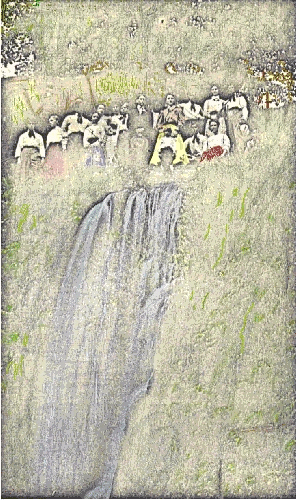

![]()
This once fantastic waterfalls has almost been destroyed by mankind. What was once a beautiful 120 foot falls in the midst of a virgin forest filled with wildflowers is now a giant mudhole with a waterfall dropping less than 10 feet.
The cave at the bottom of the sink began filling up more than 150 years ago when the surrounding virgin forests were stripped bare for farmland. The loss of undergrowth and trees caused heavy erosion on the slightly sloping countryside along the small stream leading into the sink.
Forest Falls is located about 6.7 miles due north of Whigham and about 8 miles northwest of Cairo, in Grady County, Georgia. Grady County borders Florida in deep Southwest Georgia, northeast of Tallahassee, Florida. The site is about 2 miles west of Hawthorne Trail (the Camilla-Cairo highway), Ga. Hwy. 112.
The falls are just west of Spring Hill Church. The church is located at an intersection of two county roads, one of which is the old Whigham-Newton road. The church is just south of the old community of Lime Sink (sometimes called Harrells Still).
Forest Falls is located on the western edge of what is known as the Pelham Solution Escarpment (also as the Curry Hill Escarpment). The escarpment is actually the eastern rim of the Flint River valley. To the east lies the Dougherty Plain, with level land stretching to the Atlantic coast.
Beneath an overburden of mostly loamy soils in this area lies a bed of "young" limestone that is among the most recently formed land mass in the United States. Geologists say it is was formed during the Tertiary Period of the Cenozoic Era, Earth's most recent era. At Forest Falls, the limestone was formed sometime between the Oligocene and Miocene Ephochs -- between 7,000,000 and 16,000,000 years ago --very "young" in Earth age.
Where this limestone is exposed on the surface in this area, it has been hardened by contact with surface air and sunlight causing crystallization. Inside the caves of the area however, the limestone rock is softer. The limestone is chock-full of fossils from ancient sea life.
Forest Falls has been an attraction since the first American Indians discovered the site. It became an immediate favorite for visits when the first American pioneers began settling the area in the 1820's. Over the years, it has been known by various names, including "The Lime Sink", "The Limesink", "Lime Sink", "Limesink" and "Forest Falls". Because of its sheer size, folks in the 1800's didn't bother with giving it a name...it was THE lime sink because none other could compare!
When the first pioneers described the site, the total drop of the falls, from the lip of the sink to the bottom of the pit was about 120 feet, making it the highest -- or deepest -- waterfalls in the entire Coastal Plains of the United States! By the 1870's, it had become a favorite site for sightseeing, family outings, reunions and picnics for young folk.
Photos from the 1890's up to about World War I show a beautiful waterfall making an impressive drop described as 110 to 120 feet. Between the 1890's and 1910, the site caught attention of the Georgia Geological Survey which published several state geological bulletins describing the falls and site. The first state publication describing the falls was the "Phosphates and Marls of Georgia", a bulletin published by the Survey in 1896. Another State Survey bulletin, "Underground Waters of Georgia" was published in 1908 and included a photo of the falls which you can see on our website. It was described again in "Geology of the Coastal Plain of Georgia" in 1911.
The Atlanta Journal printed several articles in the 1930's describing the falls and others in the early 1950's. By 1952, the articles described the falls as 80 feet, indicating erosion was steadily filling up the large sink.
![]()

This photo was taken between 1890-1910 and shows a group of "tourists" on a weekend picnic at the falls. The view shows the very top of the falls which dropped another 100 feet below the bottom of the photo. Such outings were popular here for many decades. Note the long dour skirts and heavy blouses on the girls which was the style during the Victorian era. The surrounding trees and plants are full of growth however, indicating the photo was taken during warm weather, despite the heavy clothing of that day.
![]()
This once magnificent falls can be restored--with your help. Contact your Georgia state representative and state senator and Governor Perdue and urge them to create a state park for this area and restore these natural treasures to their former glory. Urge them to establish a state park here to preserve these natural wonders and bring new jobs to our region.
You can send a message to Georgia Governor Perdue and let him know of your support. Take time to send him and the Georgia Parks Division and Tourist Division a note. See the Home page and click on the "Governor" icon.
![]()